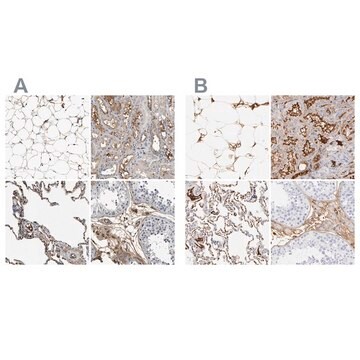SAB5801027
Goat Anti-Mouse IgG(Fcγ) Biotin Alpaca Heavy chain only Antibody
recombinant Alpaca(VHH) Nano antibody
Sinonimo/i:
Recombinant Alpaca single variable domain secondary Nanobody
About This Item
Prodotti consigliati
Origine biologica
alpaca
Ricombinante
expressed in HEK 293 cells (Human cell line)
Coniugato
biotin
Forma dell’anticorpo
affinity purified immunoglobulin
Tipo di anticorpo
secondary antibodies
Clone
polyclonal
Forma fisica
lyophilized solid
PM
100 kDa
Reattività contro le specie
mouse, Alpaca
Concentrazione
1 mg/mL
tecniche
ELISA: 1:10000-1:50000
western blot: 1:10000-1:50000
Misura
0.1 mL
Colore
colorless
Isotipo
IgG2c
VHH
N° accesso UniProt
Condizioni di spedizione
wet ice
Temperatura di conservazione
2-8°C
Descrizione generale
Most monoclonal antibodies are generated in mouse. There are five antibody isotypes (IgA, IgD, IgE, IgG, and IgM) from mouse. Each isotype has a different heavy chain. Mouse IgG constitutes 75% of serum immunoglobulins, and IgG is the predominant form of first antibody produced from mouse. Mouse IgG consists of five subclasses-IgG1, IgG2a, IgG2b, IgG2c(inbred mouse strains with the Igh1-b allele have IgG2c isotype instead of IgG2a), IgG3. They are highly homologous and differ mainly in the hinge region. The whole IgG molecule possesses both the Fc region and the Fab region, which possessing the epitope-recognition site. The IgG contains two heavy and light chains, and the heavy chain is about 50 KD and the light chain is about 25 KD. The common IgG is monomeric with a molecular weight of approximately 150 kD.
VHH are single-domain antibodies derived from the variable regions of heavy chain of Camelidae immunoglobulin. The size of VHH is extremely small(less than15KDa) compared to other forms of antibody fragment, which significantly increase the permeability of VHH. Thus VHH is considered of great value for research, diagnostics and therapeutics.
Specificità
Isotype: VHH domain of alpaca IgG2b/2c fused to goat IgG Fc
Immunogeno
Confezionamento
Stato fisico
Ricostituzione
Stoccaggio e stabilità
Altre note
Non trovi il prodotto giusto?
Prova il nostro Motore di ricerca dei prodotti.
Avvertenze
Warning
Indicazioni di pericolo
Consigli di prudenza
Classi di pericolo
Aquatic Chronic 3 - Skin Sens. 1
Codice della classe di stoccaggio
13 - Non Combustible Solids
Classe di pericolosità dell'acqua (WGK)
WGK 3
Punto d’infiammabilità (°F)
Not applicable
Punto d’infiammabilità (°C)
Not applicable
Certificati d'analisi (COA)
Cerca il Certificati d'analisi (COA) digitando il numero di lotto/batch corrispondente. I numeri di lotto o di batch sono stampati sull'etichetta dei prodotti dopo la parola ‘Lotto’ o ‘Batch’.
Possiedi già questo prodotto?
I documenti relativi ai prodotti acquistati recentemente sono disponibili nell’Archivio dei documenti.
Il team dei nostri ricercatori vanta grande esperienza in tutte le aree della ricerca quali Life Science, scienza dei materiali, sintesi chimica, cromatografia, discipline analitiche, ecc..
Contatta l'Assistenza Tecnica.
